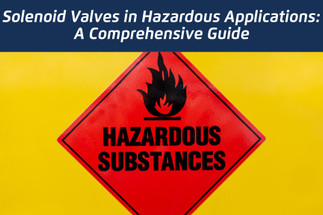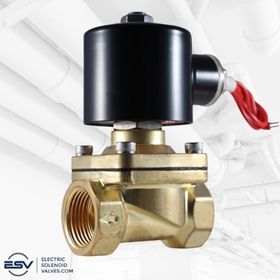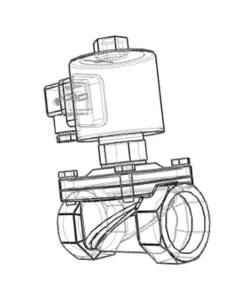Sep 27th 2023
Solenoid Valves in Hazardous Applications: A Comprehensive Guide
Automating fluid applications offers numerous benefits, particularly in hazardous industrial settings. These applications pose direct risks to operators and the environment due to the physical and chemical properties of fluids, operating pressure and temperature, and the risk of leaks around valves. Automating these applications can help to reduce the risk of accidents by eliminating human error, and it can also improve efficiency and productivity by automating repetitive tasks.
Solenoid valves are used in a variety of hazardous applications, such as chemical processing plants, oil and gas extraction and refining, mining, and flammable fluid service. They are essential for ensuring safe operations by enabling plant operators to manage multiple flow control tasks remotely.
Solenoid valves used in hazardous industrial applications are different from those used in other applications in a few ways. First, they must be able to withstand the harsh conditions of the environment in which they are used. Second, they must be able to operate reliably and safely, even in the event of a power failure. Third, they must meet specific standards and industry regulations.
This article explores the unique characteristics of solenoid valves for hazardous industrial applications. It also discusses internal and external valve designs and constructions, and how they influence operational safety and reliability. Finally, it outlines innovative solutions and technologies that are affecting future solenoid valve designs for hazardous applications.
Some of the innovative solutions and technologies that are affecting future solenoid valve designs for hazardous applications include:
- The use of new materials that are more resistant to harsh environments.
- The development of new valve designs that are more reliable and safer.
- The use of new technologies, such as smart sensors and control systems, to improve the performance of solenoid valves.
Understanding hazardous industrial applications
A facility or location is deemed hazardous when it contains or produces elements such as:
- Flammable gases, which can leak from piping, valves, or exhaust ports.
- Harmful vapors, which can be created by chemical reactions or changes in temperature and pressure.
- Corrosive service fluids.
- Dust, combustible materials, and other debris.
The presence of hazardous components in a piping system can increase the risk of accidents, such as explosions or fires. It is important to understand the hazard levels in a facility in order to take appropriate risk mitigation measures. One such measure is to select the correct type of process valves, which can help to minimize fugitive emissions, leakages, and explosions in pipelines.
Hazardous Location Classes
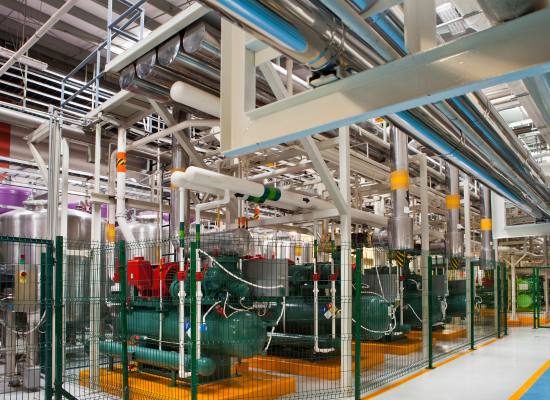
Hazardous locations in industrial settings bear different classifications, each defining the kind of hazard and level of exposure. The general classes of industrial hazard locations are:
- Class I refers to locations containing flammable gases and vapors. These vapors are continuously present in these areas and can create explosive environments. An example of a Class 1 hazard location in fluid applications is an oil refinery. The refinery handles hydrocarbons, pumped and rerouted several times when processing them into finished products. The hydrocarbons, including volatile hydrocarbons, release vapors as they transition between pumping or processing stations. These vapors are continuously present in the refinery process and can be a source of explosions or fires.
- Class II hazardous locations deal with those applications handling combustible dust. Class II hazards are a concern if the process or industrial system contains elements such as dust traps or collectors. These dusts are airborne and can explode when exposed to ignition.
- Class III hazardous locations are all those areas containing fibers or other suspended materials that can easily ignite. Typical Class III locations would be textile mills, woodworking shops, and cotton gins.
The Importance of Solenoid Valves in Hazardous Settings
Key Applications of Solenoid Valves
Solenoid valves play a vital role in managing fluid flow in hazardous applications. These valves offer adequate safety features to prevent explosions or media leakages while supporting precise and automated flow control. These valves meet the most stringent industry standards to provide proactive hazard mitigation measures. Some typical applications of solenoid valves in hazardous applications include:
- Regulating fluid flow in natural gas distribution systems
- Regulating fluid flow in chemical processing plants - involves mixing and transferring harmful chemicals in paint manufacturing facilities.
- Flow control of volatile liquids in refineries, petrochemical facilities, and hydrocarbon storage tanks.
- Chemical dosing in wastewater treatment plants
- Flow control of dust in mining operations and grain storage silos.
Meeting Industry Standards and Regulations
Given that industries have distinct standards and regulations, it's essential to familiarize oneself with these guidelines. It ensures the type of process equipment and valves selected for each application can provide adequate fluid control and conform with the hazard classes. For instance, a solenoid valve designed for regulating combustible dust may be ineffective in controlling hazardous vapors.
These valves should meet standards defined by organizations like the National Fire Protection Association (NFPA) in the United States and the International Electrotechnical Commission (IEC). Standards and regulations developed by such organizations define specific valve application areas, material specifications and guidelines for installing and maintaining solenoid valves in hazardous locations to optimize process safety.
Safety First: Design Features of Solenoid Valves
Internal Construction and Port Orientation
Solenoid valves, whether they're 2-way, 3-way, or 4-way, are designed with features to enhance safety in hazardous settings. The first safety mechanism is the internal construction and port orientation. The design of these ports and directions (ways) ensures the safe transfer of fluids from one location to the other. The ports are designed to prevent media from leaking or mixing within the valve body. The ports also open at predetermined intervals, allowing specific volumes of liquids, vapors, or other service media. It protects the valves and other equipment in the piping system.
Sealing Mechanisms and Material Choices
Another construction feature determining the safety of solenoid valves in hazardous applications is the design and type of the sealing mechanism. The sealing materials block the different ports of the solenoid valve. Usually, the sealing material withstands the system pressure and chemical aggression due to the service media. These seals are manufactured using highly engineered materials with high pressure and temperature tolerance.
The materials used to make solenoid valve bodies should be considered when looking at the chemical composition of the service media. The material must be able to withstand chemical corrosion, erosion from fast-moving fluids, and chemical reactions caused by high process temperatures or pressures. Over time, minor material erosion and corrosion can cause safety issues as the solenoid valve loses its physical strength. It can also increase leakage as the sealing surfaces develop irregularities. These deformations on the sealing surfaces create leakage points, allowing hazardous vapors and fluids to escape around the valves.
You should always consult a chemical expert, but for a quick reference, we have a free chemical compatibility guide you can use.
External Safety Features and Enclosures
High-quality industrial solenoid valves, similar to the ones stocked by Electric Solenoid Valves, have additional external safety features. These valves have robust external enclosures and housing designs. The housing designs protect the internal valve components against damage from environmental elements. These elements can cause physical damage to the solenoid valve, lowering its performance. The enclosures are fabricated from stainless steel, plastic (Polypropylene, POM Plastic, Engineered Nylon), or brass. Solenoid valves have specific mounting designs and options. These mounting options are essential for maintaining the stability of solenoid valves in piping systems.
Explosion-Proof and Intrinsically Safe Designs
Solenoid valves for hazardous applications must be explosion-proof. Achieving an explosion-proof valve design demands innovative integration of fail-proof or fail-safe technologies. The explosion-proof enclosures have an above-grade factor of safety. It ensures the solenoid valve can withstand the designed system pressure and temperature rating.
Solenoid valves for hazardous applications feature intrinsically safe electrical circuits. The design of the electrical connections in a solenoid valve ensures that energy is limited to particular levels. Keeping the energy levels within certain thresholds prevents the risk of ignition in hazardous fluid flow applications.
Additional Safety Features to Consider
Other safety features associated with solenoid valves for hazardous industrial applications include:
- Well-insulated and grounded electrical connections.
- Adequate protection against moisture
- Position indicators to show the actual state of the solenoid valve. The position indicator shows if the valve is open or closed.
- Pressure relief mechanisms. The pressure relief mechanism protects the valve against overpressure, which might cause an explosion when system disturbances and spikes occur.
- A manual override system. The manual override is an essential safety feature that allows plant operators to manage valve operations during emergencies. Such emergencies can cause loss of electrical and control signals, impeding the performance of solenoid valves. Such instances can cause accidents in hazardous fluid flow applications.
Maximizing the Durability of Solenoid Valves
Tips for Extending Solenoid Valve Lifespan
Solenoid valves are preferable for their quick responsiveness to flow control signals. These valves can provide long-term reliability despite their frequent cycling requirements. Here is how to extend the longevity of solenoid valves in hazardous applications:
- Enhance surface finishes of solenoid valve components. A smooth surface finish provides additional protection against valve seats and sealing surfaces. The smooth surface finishes prevent debris build-up, which can accelerate wear and tear.
- Use additional surface finishes and material treatment processes to improve the corrosion resistance of solenoid valves.
- Perform rigorous compatibility and safety tests on solenoid valves. The compatibility tests are necessary for verifying material performance, pressure and temperature ratings and safety of the solenoid valves for the intended applications.
- Conduct regular inspections and valve maintenance. Maintenance inspections are essential for removing debris, identifying worn-out seals, and replacing damaged valves.
Redundancy and fail-safe valve operation
Maintaining tiptop safety when dealing with hazardous fluid applications is a non-negotiable part of routine operations. Overlooking critical safety mechanisms can cause irreversible consequences spanning equipment damage or compromised processes. How can one achieve safe operations when utilizing solenoid valves for hazardous applications?
- Utilize redundant valve systems - one can utilize parallel or series solenoid valve configurations depending on the system requirements. Implementing redundant valves in a hazardous fluid application provides a means for sustaining continuous flow regulation when the primary valve fails. Customize the control logic to ensure synchronized operationalization of the backup valves when failure occurs.
- Implement an effective position feedback system - consider utilizing features like limit switches or Internet of Things (IoT) sensors to monitor the real-time status of the solenoid valves. The feedback systems can trigger safety alerts when system conditions exceed the designated safety limits. The position feedback systems are crucial for strengthening safety response in hazardous fluid applications. The feedback systems should work with emergency shutdown systems to detect and automatically stop processes in case of elevated hazards.
- Leverage solenoid valves with diagnostic and self-testing capabilities - such mechanisms are essential for detecting underlying solenoid valve issues and generating alerts timely. The self-diagnostic capabilities ensure process operators can proactively rectify these issues and maintain the desired system reliability, averting hazard propagation through leakages or fugitive emissions around the solenoid valves.
Solenoid Valve Testing and Certification
The Importance of Third-Party Testing
Testing and certifying solenoid valves for hazardous fluid applications is a safety requirement across industries. They also serve to verify the reliability scores of these valves. Electric Solenoid Valves stocks a wide range of solenoid valves that have passed the stringent industry testing and certification standards to ensure they provide value for money and offer dependable fluid control capabilities in hazardous industrial setups.
Another reason for testing solenoid valves is to satisfy the legal and regulatory requirements guiding the operations of different companies. These regulations span across environmental protection laws and facility-based safety needs. Using solenoid valves complying with regulatory standards protects companies against fines and preventable workplace accidents.
Manufacturers collaborate with third-party testing companies for their quality assurance and management processes. Testing ensures manufacturers release high-quality, industry-approved products safe for hazardous fluid flow applications.
Third-party solenoid valve testers form part of the valve supply chain. They own sophisticated testing equipment and laboratories. The testers evaluate solenoid valves marked for hazardous industrial applications against prescribed local and international standards. The testers offer an unbiased opinion on valve safety, reliability, and performance in the intended environments.
Once the testers verify the valves meet the recommended standards, they attach the necessary safety documentation and certification markings.
Understanding Certification Markings on Solenoid Valves
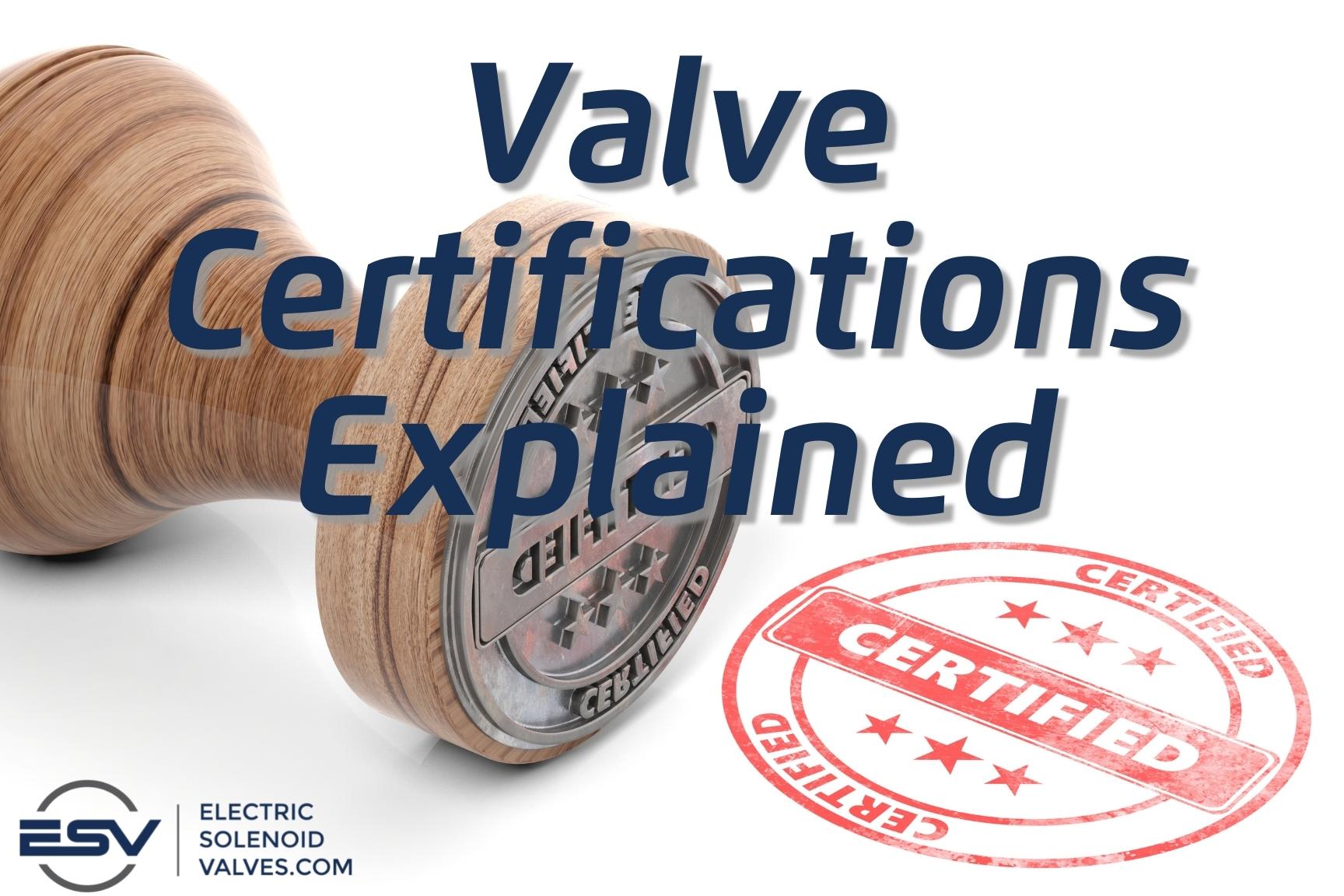 Solenoid valves have multiple markings on their bodies. Understanding these markings prevents mix-ups, especially when selecting valves for hazardous fluid applications. The markings may vary from one country to the other depending on the regulatory authority and testing standards. Markings on solenoid valves include:
Solenoid valves have multiple markings on their bodies. Understanding these markings prevents mix-ups, especially when selecting valves for hazardous fluid applications. The markings may vary from one country to the other depending on the regulatory authority and testing standards. Markings on solenoid valves include:
- UL Certification - Solenoid valves with these markings have met the testing standards prescribed by Underwriters Laboratories (UL). These markings indicate the solenoid valves meet the safety and compliance standards prescribed by North American authorities - that is, the United States and Canada.
- CE Marking/ATEX Certification - CE marking appears on solenoid valves for the European Union market. The Atmospheres Explosibles (ATEX) certification indicates the solenoid valves are safe for fluid control in potentially explosive environments. They are suitable for regulating the flow of flammable gases and vapors in different industrial processes.
- CSA Certification - CSA markings are available on solenoid valves designed for Canadian markets. The solenoid valves are tested against the Canadian Standards Association (CSA) specifications. These valves are also acceptable in selected hazardous applications in the US.
- IECEx Certification - This is an international certification by the International Electrotechnical Commission System for Certification to Standards Relating to Equipment for Use in Explosive Atmospheres. Valves with these markings are acceptable for various hazardous applications in different countries worldwide.
- NEMA Rating - National Electrical Manufacturers Association ratings determine the different environments where electrical enclosures can be used. The rating relates to the electrical casings of solenoid valves. The ratings have specific protection standards against environmental elements like moisture and dust. Choosing a valve with a suitable NEMA rating for a particular application means it can withstand the challenges associated with the hazards within the valve application area.
- IP Ratings - Ingress Protection (IP) ratings define the level of protection against the intrusion of solids and liquids into a solenoid valve. Selecting a valve with the appropriate IP rating ensures system designers can utilize an effective solenoid valve capable of withstanding the corrosive action of fluid media and hazardous environments.
Deep Dive into Valve Certifications
For those who are keen on diving deeper into the world of valve certifications, Electric Solenoid Valves has a comprehensive blog post that covers common valve certifications such as CE, RoHS, UL, CSA, and NSF. This resource provides a detailed overview of each certification, its significance, and its application in the industry. Whether you're a professional in the field or simply curious about the intricacies of valve certifications, this blog post is a must-read.
Future trends in solenoid valve designs

The design and fabrication of solenoid valves is a work in progress. Manufacturers are leveraging emerging technologies to design and fabricate better versions of solenoid valves for hazardous applications. Here are a few technologies and advancements shaping the development of solenoid valves for enhanced reliability and safety in hazardous applications:
- Precision manufacturing - The evolution of advanced manufacturing technologies promotes the fabrication of complex solenoid valve parts. Technologies like 3D printing and CNC machining enable manufacturers to design and manufacture parts with tight tolerances. These manufacturing techniques are beneficial for lowering and eliminating hazardous leakages, which can be consequential.
- Breakthroughs in material science - Research in material science has led to the discovery of advanced valve bodies and sealing materials. These materials have better performance characteristics. Think of better corrosion resistance, enhanced durability and better temperature and pressure ratings. It implies that future solenoid valves will handle more complex hazardous applications while exhibiting improved reliability and safety.
- Enhanced sensor technology - There is remarkable progress in industrial sensors and feedback systems technology. These devices are vital for monitoring the real-time performance of multiple solenoid valves in hazardous environments.
The advancements in industrial sensors are in line with the rise of the Industrial Internet of Things (IIoT). This new technology is transforming how companies operate and monitor solenoid valves in hazardous applications. Plant operators can remotely monitor solenoid valves, tracking variables like system pressure, flow rates, sealing efficiency and media leakage rates. It reduces manual inspections, which can increase exposure to life-threatening hazards.
IIoT technology and real-time valve performance data are crucial for developing and sustaining effective predictive maintenance schedules for solenoid valves in hazardous environments. Valve-embedded sensors track round-the-clock system performances, identifying anomalies or conditions that negatively impact valve safety and reliability. Companies can utilize such data to effectively schedule valve maintenance and initiate planned equipment shutdowns for mandatory valve replacements and reconditioning.
IIoT technology is also beneficial for centralizing valve performance analytics. Solenoid valve performance data can provide insights into indicators like energy efficiency and utilization in hazardous applications. Companies can leverage this information to identify opportunities for reducing energy costs and minimizing harmful emissions in hazardous fluid applications.
Moving forward, solenoid valve manufacturers should keep an eye on emerging technologies. Artificial intelligence is poised to disrupt the manufacture and utilization of solenoid valves in hazardous applications. Here's how AI can be applied in the context of solenoid valves for hazardous applications:
- Performing advanced valve simulations for improved product design and development. Manufacturers can model and predict the behaviors of solenoid valves in different application environments. Manufacturers can also optimize valve designs by iterating various proposed valve designs to ensure they are safe and efficient for hazardous environments.
- AI can facilitate material selection processes. The systems can analyze valve fabrication material properties and estimate their effectiveness in intended applications.
- AI can be utilized to perform reliability and failure mode analysis. Manufacturers can identify potential failure modes and conditions that can accelerate such failures. Such studies are vital for developing effective preventive measures to ensure optimal safety of solenoid valves.
Ensuring Safety with Solenoid Valves
Solenoid valves complement safety measures in hazardous industrial applications. One should extensively explore the conditions of the operating environment and evaluate industry standards before settling on specific solenoid valves. You can always consult Electric Solenoid Valves for all your solenoid valve needs. We stock a wide range of high-quality solenoid valves that satisfy various industry standards to ensure all your industrial processes are safe.

